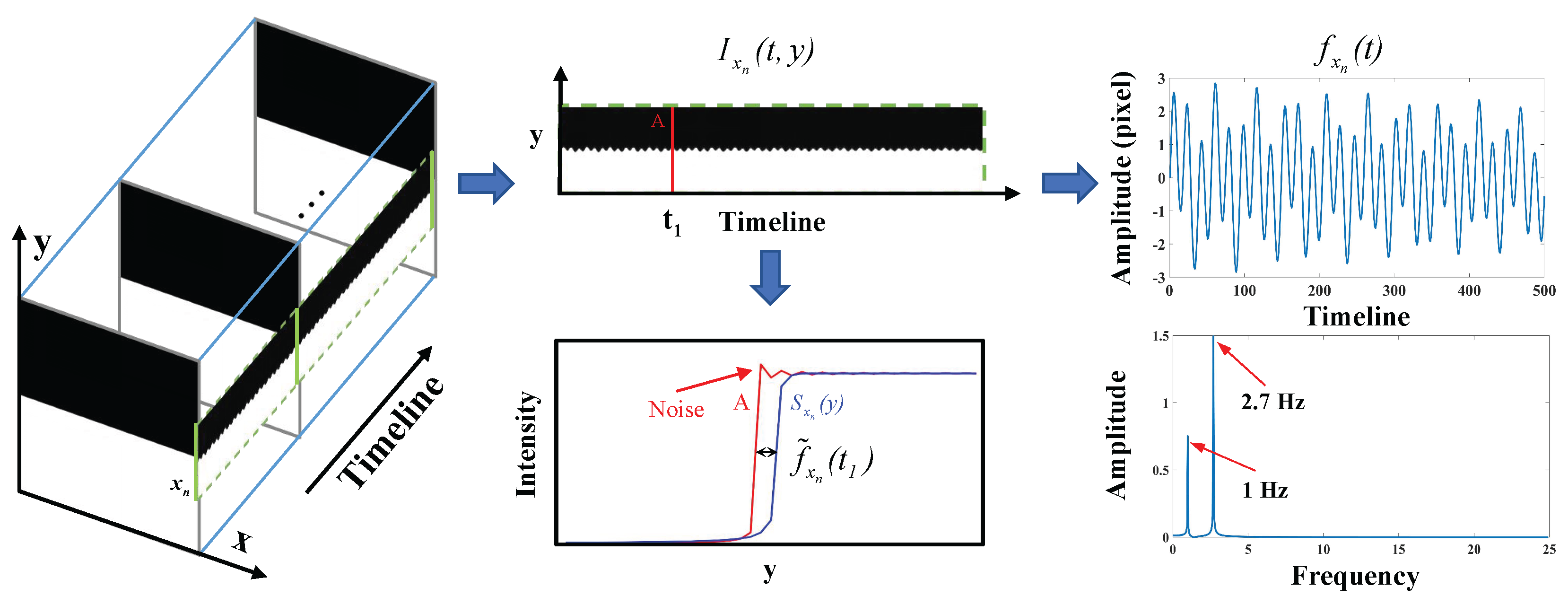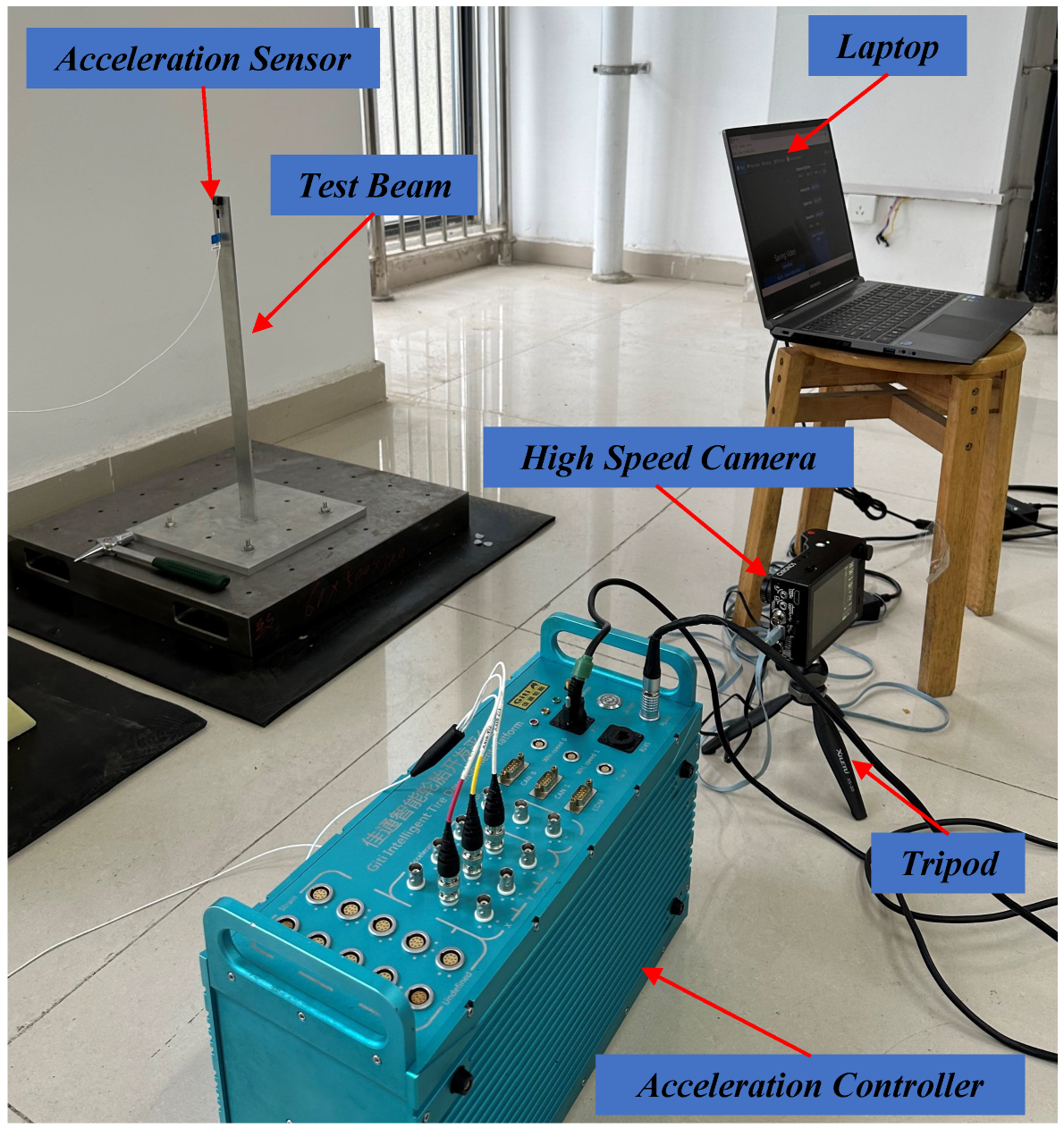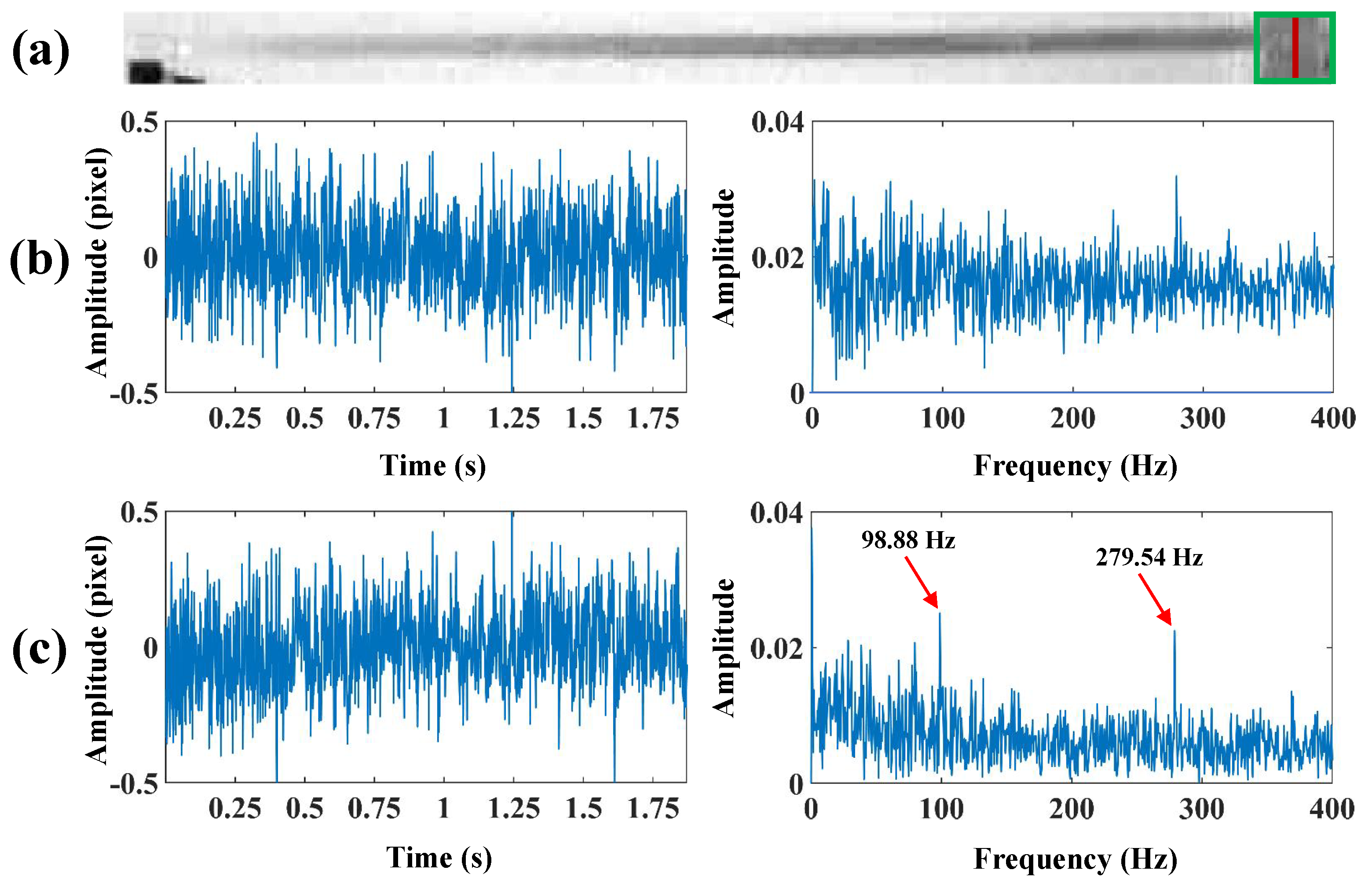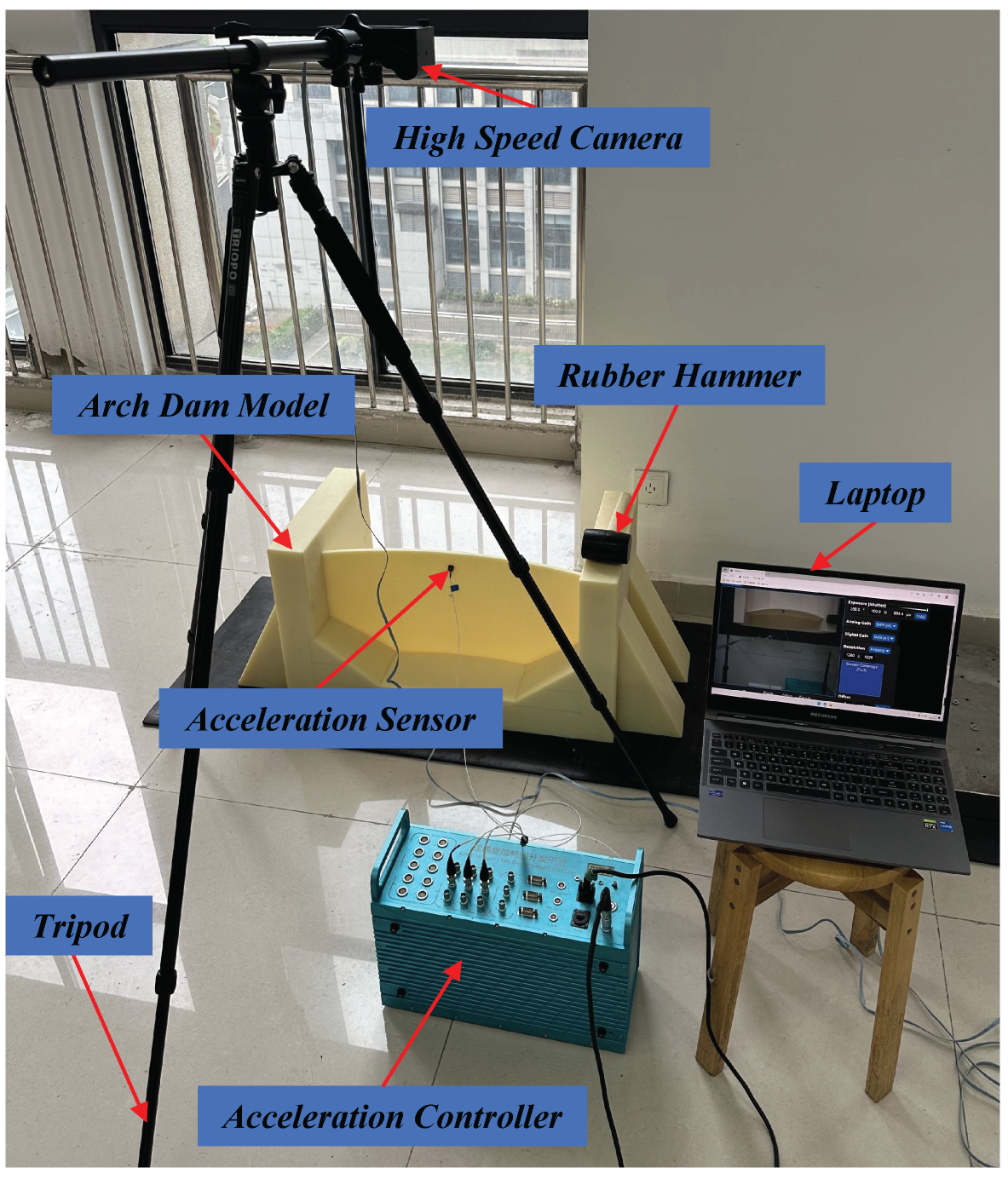Efficient Vibration Measurement and Modal Shape Visualization Based on Dynamic Deviations of Structural Edge Profiles
Abstract
:1. Introduction
2. Materials and Methods
2.1. Dynamic Deviations and Vibration
2.2. Unilateral and Bilateral Samplings
2.3. Estimation of Spatial Weight
2.3.1. Temporal Processing
2.3.2. Spatial Processing
3. Results
3.1. Experiment of the Beam
3.2. Experiment of the Arch Dam Model
4. Discussion
5. Conclusions
Author Contributions
Funding
Institutional Review Board Statement
Informed Consent Statement
Data Availability Statement
Acknowledgments
Conflicts of Interest
References
- Delgadillo, R.M.; Casas, J.R. Bridge damage detection via improved completed ensemble empirical mode decomposition with adaptive noise and machine learning algorithms. Struct. Control. Health Monit. 2022, 29, e2966. [Google Scholar] [CrossRef]
- Wada, D.; Igawa, H.; Kasai, T. Vibration monitoring of a helicopter blade model using the optical fiber distributed strain sensing technique. Appl. Opt. 2016, 55, 6953–6959. [Google Scholar] [CrossRef] [PubMed]
- Hızal, Ç. Frequency domain data merging in operational modal analysis based on least squares approach. Measurement 2021, 170, 108742. [Google Scholar] [CrossRef]
- Xue, Z.-P.; Wang, C.; Li, M.; Wang, C.; Jia, H.; Yu, Y. Image-based method for the angular vibration measurement of a linear array camera. Appl. Opt. 2021, 60, 1003–1012. [Google Scholar]
- Xu, Y.; Brownjohn, J.M.; Hester, D. Enhanced sparse component analysis for operational modal identification of real-life bridge structures. Mech. Syst. Signal Process. 2019, 116, 585–605. [Google Scholar] [CrossRef]
- Altunişik, A.C.; Günaydin, M.; Sevim, B.; Bayraktar, A.; Adanur, S. Dynamic Characteristics of an Arch Dam Model before and after Strengthening with Consideration of Reservoir Water. J. Perform. Constr. Facil. 2016, 30, 06016001. [Google Scholar] [CrossRef]
- Sheng, Z.; Chen, B.; Hu, W.; Yan, K.; Miao, H.; Zhang, Q.; Yu, Q.; Fu, Y. LDV-induced stroboscopic digital image correlation for high spatial resolution vibration measurement. Opt. Express 2021, 29, 28134–28147. [Google Scholar] [CrossRef]
- Zhang, W.; Tao, Y.; Wu, Y.; Zhu, F.; Cai, W.; Liu, N.; Zhao, Q.; Xue, P. Vibration measurement with frequency modulation single-pixel imaging. Chin. Opt. Lett. 2023, 21, 011102. [Google Scholar] [CrossRef]
- Feng, D.; Feng, M.Q. Computer vision for SHM of civil infrastructure: From dynamic response measurement to damage detection—A review. Eng. Struct. 2018, 156, 105–117. [Google Scholar] [CrossRef]
- Feng, D.; Feng, M.Q. Experimental validation of cost-effective vision-based structural health monitoring. Mech. Syst. Signal Process. 2017, 88, 199–211. [Google Scholar] [CrossRef]
- Cakar, O.; Sanliturk, K. Elimination of transducer mass loading effects from frequency response functions. Mech. Syst. Signal Process. 2005, 19, 87–104. [Google Scholar] [CrossRef]
- Wang, X.; Li, F.; Du, Q.; Zhang, Y.; Wang, T.; Fu, G.; Lu, C. Micro-amplitude vibration measurement using vision-based magnification and tracking. Measurement 2023, 208, 112464. [Google Scholar] [CrossRef]
- Khuc, T.; Nguyen, T.A.; Dao, H.; Catbas, F.N. Swaying displacement measurement for structural monitoring using computer vision and an unmanned aerial vehicle. Measurement 2020, 159, 107769. [Google Scholar] [CrossRef]
- Zhang, D.; Hou, W.; Guo, J.; Zhang, X. Efficient subpixel image registration algorithm for high precision visual vibrometry. Measurement 2021, 173, 108538. [Google Scholar] [CrossRef]
- Wang, J.; Zhao, W.; Leach, R.; Xu, L.; Lu, W.; Liu, X. Positioning error calibration for two-dimensional precision stages via globally optimized image registration. Measurement 2021, 186, 110222. [Google Scholar] [CrossRef]
- Dai, X.; Qi, J.; Xu, M.; Zhang, W.; Wang, Y.; Zhang, J.; Yang, W. Omnidirectional 3D-DIC method for determining inner deformation in pipelines. Measurement 2023, 216, 112924. [Google Scholar] [CrossRef]
- Cofaru, C.; Philips, W.; Paepegem, W.V. A three-frame digital image correlation (DIC) method for the measurement of small displacements and strains. Meas. Sci. Technol. 2012, 23, 105406. [Google Scholar] [CrossRef]
- Reu, P.L.; Rohe, D.P.; Jacobs, L.D. Comparison of DIC and LDV for practical vibration and modal measurements. Mech. Syst. Signal Process. 2017, 86, 2–16. [Google Scholar] [CrossRef]
- Wadhwa, N.; Rubinstein, M.; Durand, F.; Freeman, W.T. Phase-Based Video Motion Processing. ACM Trans. Graph. 2013, 32, 1–10. [Google Scholar] [CrossRef]
- Wadhwa, N.; Wu, H.Y.; Davis, A.; Rubinstein, M.; Shih, E.; Mysore, G.J.; Chen, J.G.; Buyukozturk, O.; Guttag, J.V.; Freeman, W.T.; et al. Eulerian Video Magnification and Analysis. Commun. ACM 2016, 60, 87–95. [Google Scholar] [CrossRef]
- Southwick, M.; Mao, Z.; Niezrecki, C. Volumetric Motion Magnification: Subtle Motion Extraction from 4D Data. Measurement 2021, 176, 109211. [Google Scholar] [CrossRef]
- Wu, H.Y.; Rubinstein, M.; Shih, E.; Guttag, J.; Durand, F.; Freeman, W.T. Eulerian Video Magnification for Revealing Subtle Changes in the World. ACM Trans. Graph. (Proc. Siggraph 2012) 2012, 31, 1–8. [Google Scholar] [CrossRef]
- Cho, D.; Gong, J. A Feasibility Study on Extension of Measurement Distance in Vision Sensor Using Super-Resolution for Dynamic Response Measurement. Sensors 2023, 23, 8496. [Google Scholar] [CrossRef] [PubMed]
- Chen, Z.; Ruan, X.; Zhang, Y. Vision-Based Dynamic Response Extraction and Modal Identification of Simple Structures Subject to Ambient Excitation. Remote. Sens. 2023, 15, 962. [Google Scholar] [CrossRef]
- Lei, X.; Jin, Y.; Guo, J.; Zhu, C. Vibration extraction based on fast NCC algorithm and high-speed camera. Appl. Opt. 2015, 54, 8198–8206. [Google Scholar] [CrossRef] [PubMed]
- Sarrafi, A.; Mao, Z.; Niezrecki, C.; Poozesh, P. Vibration-based damage detection in wind turbine blades using Phase-based Motion Estimation and motion magnification. J. Sound Vib. 2018, 421, 300–318. [Google Scholar] [CrossRef]
- Chen, J.G.; Wadhwa, N.; Cha, Y.J.; Durand, F.; Freeman, W.T.; Buyukozturk, O. Modal identification of simple structures with high-speed video using motion magnification. J. Sound Vib. 2015, 345, 58–71. [Google Scholar] [CrossRef]
- Zhang, D.; Zhu, A.; Wang, Y.; Guo, J. Hybrid-driven structural modal shape visualization using subtlevariations in high-speed video. Appl. Opt. 2022, 61, 8745–8752. [Google Scholar] [CrossRef] [PubMed]
- Zhang, Q.; Su, X. High-speed optical measurement for the drumhead vibration. Opt. Express 2005, 13, 3110–3116. [Google Scholar] [CrossRef] [PubMed]
- Wadhwa, N.; Dekel, T.; Wei, D.; Durand, F.; Freeman, W.T. Deviation Magnification: Revealing Departures from Ideal Geometries. ACM Trans. Graph. 2015, 34. [Google Scholar] [CrossRef]
- Dragomiretskiy, K.; Zosso, D. Variational Mode Decomposition. IEEE Trans. Signal Process. 2014, 62, 531–544. [Google Scholar] [CrossRef]
- Hong, N.; Tang, C.; Xu, M.; Lei, Z. Phase retrieval for objects in rain based on a combination of variational image decomposition and variational mode decomposition in FPP. Appl. Opt. 2022, 61, 6704–6713. [Google Scholar] [CrossRef] [PubMed]
- Mazzeo, M.; De Domenico, D.; Quaranta, G.; Santoro, R. Automatic modal identification of bridges based on free vibration response and variational mode decomposition technique. Eng. Struct. 2023, 280, 115665. [Google Scholar] [CrossRef]
- Chang, Z.; Gao, Q.; Monti, G.; Yu, H.; Yuan, S. Selection of pulse-like ground motions with strong velocity-pulses using moving-average filtering. Soil Dyn. Earthq. Eng. 2023, 164, 107574. [Google Scholar] [CrossRef]
- Harmanci, Y.E.; Gülan, U.; Holzner, M.; Chatzi, E. A Novel Approach for 3D-Structural Identification through Video Recording: Magnified Tracking. Sensors 2019, 19, 1229. [Google Scholar] [CrossRef]
- Sevim, B.; Bayraktar, A.; Altunişik, A.; Adanur, S.; Akköse, M. Determination of water level effects on the dynamic characteristics of a prototype arch dam model using ambient vibration testing. Exp. Tech. 2012, 36, 72–82. [Google Scholar] [CrossRef]
- Gomes, J.P.; Lemos, J.V. Characterization of the dynamic behavior of a concrete arch dam by means of forced vibration tests and numerical models. Earthq. Eng. Struct. Dyn. 2020, 49, 679–694. [Google Scholar] [CrossRef]













| Model | Sensor | Maximum Resolution | FPS at Maximum Resolution | Memory Capacity | Shutter |
|---|---|---|---|---|---|
| Chronos 2.1-HD | CMOS | 1280 × 1024 pixels | 1069 fps | 32 GB | Global shutter |
| Young’s Modulus (GPa) | Density (kg · m) | Mode Order | Simulation (Hz) | Experiment (Hz) | Error (%) |
|---|---|---|---|---|---|
| 1 | 15.47 | 15.50 | 0.19 | ||
| 72 | 2 | 96.87 | 98.88 | 2.07 | |
| 3 | 271.16 | 279.54 | 3.09 |
| Proposed Method | |||
|---|---|---|---|
| Mode 1 | Mode 2 | Mode 3 | |
| Finite element simulation | 0.9971 | 0.9524 | 0.9887 |
| Mode Order | Simulation (Hz) | Experiment (Hz) | Error Rate (%) |
|---|---|---|---|
| 1 | 169.82 | 171.04 | 0.72 |
| 2 | 206.39 | 203.11 | 1.59 |
| 3 | 284.95 | 277.94 | 2.46 |
Disclaimer/Publisher’s Note: The statements, opinions and data contained in all publications are solely those of the individual author(s) and contributor(s) and not of MDPI and/or the editor(s). MDPI and/or the editor(s) disclaim responsibility for any injury to people or property resulting from any ideas, methods, instructions or products referred to in the content. |
© 2024 by the authors. Licensee MDPI, Basel, Switzerland. This article is an open access article distributed under the terms and conditions of the Creative Commons Attribution (CC BY) license (https://creativecommons.org/licenses/by/4.0/).
Share and Cite
Zhu, A.; Gong, X.; Zhou, J.; Zhang, X.; Zhang, D. Efficient Vibration Measurement and Modal Shape Visualization Based on Dynamic Deviations of Structural Edge Profiles. Sensors 2024, 24, 4413. https://doi.org/10.3390/s24134413
Zhu A, Gong X, Zhou J, Zhang X, Zhang D. Efficient Vibration Measurement and Modal Shape Visualization Based on Dynamic Deviations of Structural Edge Profiles. Sensors. 2024; 24(13):4413. https://doi.org/10.3390/s24134413
Chicago/Turabian StyleZhu, Andong, Xinlong Gong, Jie Zhou, Xiaolong Zhang, and Dashan Zhang. 2024. "Efficient Vibration Measurement and Modal Shape Visualization Based on Dynamic Deviations of Structural Edge Profiles" Sensors 24, no. 13: 4413. https://doi.org/10.3390/s24134413







